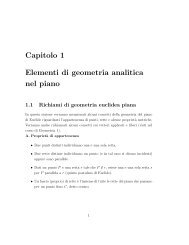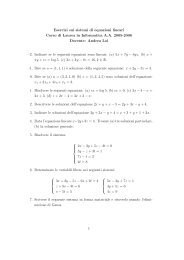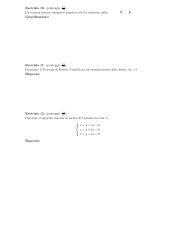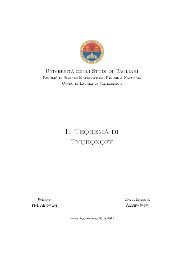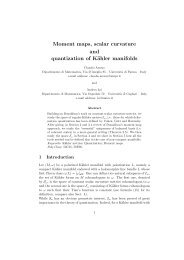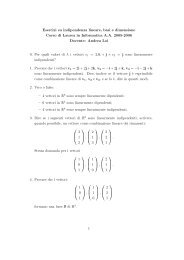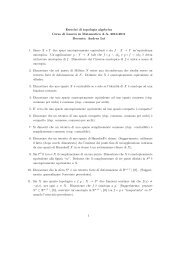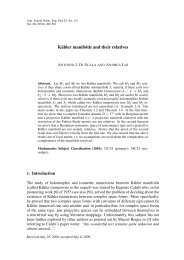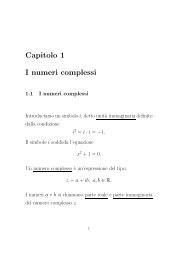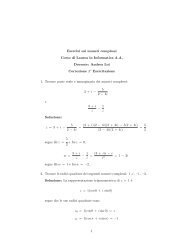Algebre di Lie semisemplici, sistemi di radici e loro classificazione
Algebre di Lie semisemplici, sistemi di radici e loro classificazione
Algebre di Lie semisemplici, sistemi di radici e loro classificazione
You also want an ePaper? Increase the reach of your titles
YUMPU automatically turns print PDFs into web optimized ePapers that Google loves.
42 CAPITOLO 3. ALGEBRE DI LIE SEMISEMPLICI<br />
Lo stesso vale se I contiene y, perché allora contiene anche h ([x, y] = h) e quin<strong>di</strong> x ([x, h] = −2x).<br />
Se invece a = b = 0, allora c h = 0. Allora c = 0 e h ∈ I, per cui I contiene x ([x, h] = −2x) ed y<br />
([y, h] = 2y). Segue I = L.<br />
Possiamo concludere che L é semplice in quanto [L, L] = 0, basti prendere l’esempio<br />
⎡ ⎤ ⎡ ⎤ ⎡ ⎤ ⎡ ⎤ ⎡ ⎤ ⎡ ⎤ ⎡ ⎤<br />
1<br />
⎣<br />
0<br />
0 0<br />
⎦ ⎣<br />
0 0<br />
1 0<br />
⎦ − ⎣<br />
0 0<br />
1 1<br />
⎦ ⎣<br />
0 0<br />
0 0<br />
⎦ = ⎣<br />
0 0<br />
1 0<br />
⎦ − ⎣<br />
0 0<br />
0 0<br />
⎦ = ⎣<br />
0 0<br />
0<br />
⎦)<br />
0<br />
Calcoliamo la matrice associata alla forma <strong>di</strong> Killing <strong>di</strong> sl(2, F ) rispetto alla base standard.<br />
Prima <strong>di</strong> tutto abbiamo bisogno <strong>di</strong> trovare le matrici associate ad ad x, ad h, ad y, sempre rispetto alla<br />
base standard<br />
Partiamo da ad x e calcoliamo ad x(x), ad x(h), ad x(y) : le <strong>loro</strong> componenti rispetto a x, h, y saranno<br />
le colonne della matrice associata ad ad x rispetto alla base fissata. Questi commutatori li abbiamo<br />
calcolati, quin<strong>di</strong> sono noti i risultati :<br />
ad x(x) = [x, x] = 0 ; ad x(h) = [x, h] = −2x ; ad x(y) = [x, y] = h (3.40)<br />
Dunque la matrice cercata risulta :<br />
ad x =<br />
⎛<br />
⎜<br />
⎝<br />
0 −2 0<br />
0 0 1<br />
0 0 0<br />
Allo stesso modo proce<strong>di</strong>amo per quanto riguarda ad h:<br />
la cui matrice é :<br />
Infine rimane ad y :<br />
con matrice :<br />
ad h(x) = [h, x] = 2x ; ad h(h) = [h, h] = 0 ; ad h(y) = [h, y] = −2y (3.41)<br />
ad h =<br />
⎛<br />
⎜<br />
⎝<br />
2 0 0<br />
0 0 0<br />
0 0 −2<br />
ad y(x) = [y, x] = −h ; ad y(h) = [y, h] = 2y ; ad y(y) = [y, y] = 0 (3.42)<br />
ad y =<br />
⎛<br />
⎜<br />
⎝<br />
0 0 0<br />
−1 0 0<br />
0 2 0<br />
Per trovare la matrice associata a k ora dobbiamo calcolare :<br />
⎛<br />
⎞<br />
0 0 −2<br />
⎜<br />
⎟<br />
k11 = tr(ad x ◦ ad x) = tr ⎜<br />
⎝ 0 0 0 ⎟<br />
⎠ = 0<br />
⎞<br />
⎟<br />
⎠<br />
⎞<br />
⎟<br />
⎠<br />
⎞<br />
⎟<br />
⎠<br />
0 0 0





